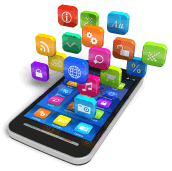How to Find Mobile Apps for Home Health Care
 Try Appolicious and let us know what you think in the comments below.
Try Appolicious and let us know what you think in the comments below.
This article was originally published in June 2011 but is republished due to high interest in finding apps. It’s based on The Best Tools to Help you Discover New Mobile Apps, by Hillel Fuld, but I removed CHOMP, since that search tool seems to have disappeared.
Back in June ’11, there were over 500,000 iOS apps (for iPhone, iPad and iPod) and 250,000 Android apps, as well as apps for BlackBerry, Nokia, WebOS, Windows Phone 7, and other platforms. They’re almost all quite affordable or free, and many are dedicated to health and fitness. But the number is still so overwhelming that finding what you need a challenge.
The tremendous variety is good news for consumers, but how do you find the best apps for your needs and filter out the junk? It’s so out of control that startups and established companies are responding with even more apps – to help you find apps.
Of the various app-discovery apps listed, we liked Appolicious because it is affiliated with Yahoo!, it’s able to exploit a great search engine, and it adds social networking so you can see what apps your friends are using.
For our test, we used Appolicious to search by keyword and to browse the Health & Fitness category, where we found over 22,000 Health & Fitness apps in the following subcategories.
- Biking
- Dental Health
- Exercise
- Fitness
- Fitness Trackers
- Medical
- Disease Reference
- Drug Reference
- First Aid
- HIV/AIDS
- Immunization Schedule
- Lab Values
- Medical Calculators
- Medical Coding
- OB/GYN
- Pediatrics
- Meditation
- Nutrition
- Relaxation
- Ride Trackers
- Run Trackers
- Sleep
- White Noise
- Walking
- Weight Loss
- Calorie Trackers
- Diet
- Women’s Health
- Conception
- Menstruation
- Pregnancy
- Yoga
More Discovery Apps
Fuld’s article includes several other app discovery programs, including smartphone apps. They include: Appboy, AppPicker, Appsfire, Discovr, Frenzapp, and Zwapp. (mHealthTalk update: Health professional should look into Happtique, described in a comment below.)
If you know of others or want to share your experience finding apps, please comment below.
Some Perspective on the Numbers
Whether it’s 500,000 or 22,000, it’s still a flood of apps that’s getting out of control. Let me put the numbers in perspective by reflecting on the early days of the IBM PC. I was an IBM systems engineer in San Antonio and remember buying a 2” thick book cataloging 3,000 PC apps just 6 months after product launch – unheard of.
I bought a full blown model of IBM’s first PC because the entire cost (nearly $5,000 retail price, and that’s in 1981 dollars) could be deducted from my pay each month, and I got an employee discount of about 20%. In case you’re wondering, that PC had a 4.77 MHz Intel microprocessor, 64KB of memory, two 120KB floppy disk drives, a monochrome monitor, a matrix printer, a 300 bps telephone modem, the PC DOS operating system, VisiCalc spreadsheet program, EasyWriter word processor, IBM BASIC programming language, and IBM Communications Manager software for connecting to remote bulletin boards. Now compare that, and the “unheard of” 3,000 apps, with today’s smartphone market.

The Evolving Landscape of Medical Apps in Healthcare does a good job addressing the large number of available apps but offers no advice for how to navigate the clutter, so I commented to ask the author for suggestions.
A new Advance Care Plans CAN go where you go transforming the dynamics faced in a medical emergency.
Now you can Carry key information on primary & secondary proxy, primary care physician & specialists, emergency contacts, insurance, and medical condition.A Advance Smartphone App for your Advance Care Plans are with you 24/7 transforming the dynamics faced in a medical emergency.
If you’re a health professional, look into Happtique. It’s a mobile app store developed by healthcare professionals, for healthcare professionals that offers hospitals, continuing care facilities, and physician practices the ability to create individually branded, secure substores that support employee and patient mobile technology use.
Happtique uses a vetting process to ensure quality, asking specialists to rate apps that apply to their specialty. Each healthcare app, or hApp, is assigned to at least one major audience (e.g., physician, nurse, pharmacist, etc.) and at least one broad topic (e.g., heart/cardiovascular). Each hApp is also “tagged” for more precise audiences (e.g., specific medical, nursing, dental specialties, etc.) and topics (specific cancers, diabetes, asthma, etc.) so you can stop searching for healthcare apps and start finding them.
Be sure to read Pat Pound’s article on Accessible iPhone Apps. Pat is blind and spent over 30 years in accessibility policy for the State of Texas and describes 70 of her favorite iPhone Apps.